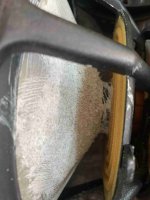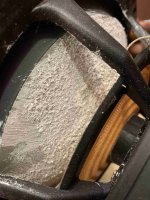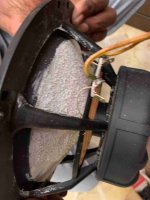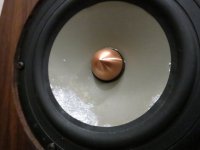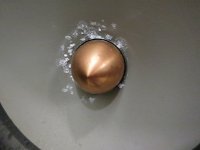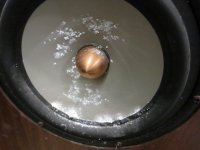One of the big advantages of the mag excel cones was always their complete absence of all midrange distortion spikes across their usable range.
I used to buy metal cones for this reason too. The idea that they were “purely pistonic” up until the (albeit) large breakup modes.
MarkK discussed the effect of small midrange resonances here:
Linear distortion
Erin measured small but definite midrange resonances, on and off axis, for the SB17CAC here
SB Acoustics SB17CAC35-4 6 Inch Ceramic Midwoofer Review
So I wonder whether we weren’t able to measure these resonances 20 years ago, when SEAS first released their magnesium cones, claiming “complete absence of midrange resonances”
Maybe they were always there, but difficult to capture?
Hobby Hifi measured W18EX003 in Feb 2021- it is an excellent driver- closely on par in the midrange to the Purifi 6.5TTW04 (original 6.5”), but higher sensitivity, only slightly worse distortion in mid-bass. The Purif does really well in the frequency response/waterfall.
In the same issue the SB17 Series were measured; the CAC/NBAC/NRX2; and they are on par between 200Hz to 2Khz, but at lower performance, as a group in the mid-bass.
I’m not sure how audible this is, given the effects of the of the room on this area, as well as human ears to bass distortion eg. CEA2010.
Over the years I’ve had too many drivers including the venerable 18W/8545 and
W18E001. I wonder if the new drivers are really just incremental improvements over the classic, but very good Scan-Speak and SEAS models
The W19NX is probably the true successor to the W18EX001
Did you see a 2nd order distortion spike in Hobby hifi test?
Klang+Ton magazine also reviewed these drivers, but W16NX003 has no such 2nd order distortion spikes. It did shown on W19NX and to some extend new W18EX. Strange!
If possible, some partial scan of the test graph is appreciated.. but I know there's copy right issues. Anyways just too curious.
My theory is that, the wide surround versions (W16NX, W19NX) are more prone to these surround distortions, even though they use the same cone(?) as W15 and W18s, the breakup node is also shifted to a bit lower frequency. Impedance graph is a good indicator.
Visiting my parents during vacation and listening to some music on their speakers.
(modified Thor based speaker with reworked crossover courtesy of Jim Mitchell and my own bass reflex tuning about 15 years ago)
It has spent the last 2 decades in a very temperate environment in the south west corner of the world (Perth, Western Australia). The climate here is characterised as typically Mediterranean- dry hot summers and mildly cold, only mildly wet winters). It is NOT a humid climate.
Yet the degradation started on the rear of the cone about 10 years into life, now the front of the cone looks like this:
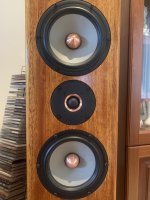
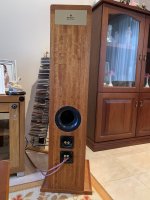
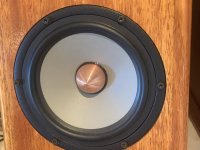


Although 20 years is a fair lifespan for transducers, cone deterioration when the rest of the driver is fine is probably not satisfactory for OEMs.
One would have to wonder how much of the graphene coating has to do with improving longevity, if nothing else.
Sooner or later these drivers will need replacement, and cost of these 176mm OD drivers is a pretty penny.
(modified Thor based speaker with reworked crossover courtesy of Jim Mitchell and my own bass reflex tuning about 15 years ago)
It has spent the last 2 decades in a very temperate environment in the south west corner of the world (Perth, Western Australia). The climate here is characterised as typically Mediterranean- dry hot summers and mildly cold, only mildly wet winters). It is NOT a humid climate.
Yet the degradation started on the rear of the cone about 10 years into life, now the front of the cone looks like this:



Although 20 years is a fair lifespan for transducers, cone deterioration when the rest of the driver is fine is probably not satisfactory for OEMs.
One would have to wonder how much of the graphene coating has to do with improving longevity, if nothing else.
Sooner or later these drivers will need replacement, and cost of these 176mm OD drivers is a pretty penny.
Last edited:
And now the rear of the cone looks like this:
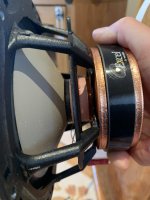

Taking apart these things, handling them, from the solid copper phase plug to copper plated motor, they are the most gorgeous “high end” drivers I have had, bar none.
They probably have another 10 years of life left. Substitution cost for (more corrosion resistant) W18EX003 is higher, topping out at is €350 for the W19NX001

Taking apart these things, handling them, from the solid copper phase plug to copper plated motor, they are the most gorgeous “high end” drivers I have had, bar none.
They probably have another 10 years of life left. Substitution cost for (more corrosion resistant) W18EX003 is higher, topping out at is €350 for the W19NX001
Last edited:
I live in Mumbai, India and my Excel cones (circa 2012) are much worse. I am importing a new set from Madisound to replace these drivers. SEAS claims that the new coating (post-2019) is better. Please pray.Visiting my parents during vacation and listening to some music on their speakers.
(modified Thor based speaker with reworked crossover courtesy of Jim Mitchell and my own bass reflex tuning about 15 years ago)
It has spent the last 2 decades in a very temperate environment in the south west corner of the world (Perth, Western Australia). The climate here is characterised as typically Mediterranean- dry hot summers and mildly cold, only mildly wet winters). It is NOT a humid climate.
Yet the degradation started on the rear of the cone about 10 years into life, now the front of the cone looks like this:
View attachment 1096179 View attachment 1096180
View attachment 1096176 View attachment 1096177 View attachment 1096178
Although 20 years is a fair lifespan for transducers, cone deterioration when the rest of the driver is fine is probably not satisfactory for OEMs.
One would have to wonder how much of the graphene coating has to do with improving longevity, if nothing else.
Sooner or later these drivers will need replacement, and cost of these 176mm OD drivers is a pretty penny.
Attachments
That's what SEAS told me too. Let's hope they are right. I live in a tropical country about 500m (1500 ft) from the Arabian sea.Yes, the surface treatment components mix are changed since then, you should have no worries buying Seas.
Ouch, I still have a pair of pre-2019 W22EX001 sitting around in box.
@navin, how many years did it take to begin showing visible corrosion?
Seems always worse at the back of cone. I wonder if sealed/passive radiator speaker(with some silica bags inside) will be better.
@navin, how many years did it take to begin showing visible corrosion?
Seems always worse at the back of cone. I wonder if sealed/passive radiator speaker(with some silica bags inside) will be better.
Its a worth tradeoff for exchanging dive units every few yearsabout 500m (1500 ft) from the Arabian sea.
I, too, wonder why the rear of the cone is worse. I noticed initial degradation about four years ago (2017-18). I carefully brushed it off and lightly applied automotive protection costing on the front and rear of the cones.Ouch, I still have a pair of pre-2019 W22EX001 sitting around in box.
@navin, how many years did it take to begin showing visible corrosion?
Seems always worse at the back of cone. I wonder if sealed/passive radiator speaker(with some silica bags inside) will be better.
A very good hospital occupies the beach. When my wife was carrying, the family joke was, "all I needed to do was put her in a wheelchair and let it roll".Its a worth tradeoff for exchanging dive units every few years
We are at an elevation of 250m or so. It's a climb when you have to do it 10-12 times a day, but it keeps the calf muscles toned. The good side is that except for a few really sultry days, we do not need any air conditioners. Some days it's so windy we have to close all the windows leaving just cracks open for ventilation. The monsoons are both terrific and terrifying depending on the day.
My MIL lives less than 10m from the sea. You can feel her apartment (she is on the 12th floor) sway on very stormy days. She has to change her washing machines, TVs etc. every three years. You won't believe how corrosive saline air is.
Goodness I’ve never seen it that bad.
The corrosion has totally destroyed the cone!
I currently live in a tropical city- the minimum temperature being 19 degrees C during the dry "winter" months, the maximum is 31.5 to 33.5 on any given day, and the humidity reaches 60-80% during the humid "buildup" and "wet monsoonal" , which is ~6-9 months of the year. In short, it's HOT and HUMID.
Storms, lightning and thunder are all spectacular, but interruption in electricity supply, risk of tropical cyclones, not so much
I left those speakers at my parents house, which is drier in humidity, cooler in climate and much less prone to rainfall. And that's made all the difference. That was the early 2000s.
I guess I should count my lucky stars that my drivers have lasted 20 years.
Perhaps its time to order the W19NX001 and take some measurements for the benefit of the DIY community- has anyone seen independent measurements?
The corrosion has totally destroyed the cone!
I currently live in a tropical city- the minimum temperature being 19 degrees C during the dry "winter" months, the maximum is 31.5 to 33.5 on any given day, and the humidity reaches 60-80% during the humid "buildup" and "wet monsoonal" , which is ~6-9 months of the year. In short, it's HOT and HUMID.
Storms, lightning and thunder are all spectacular, but interruption in electricity supply, risk of tropical cyclones, not so much
I left those speakers at my parents house, which is drier in humidity, cooler in climate and much less prone to rainfall. And that's made all the difference. That was the early 2000s.
I guess I should count my lucky stars that my drivers have lasted 20 years.
Perhaps its time to order the W19NX001 and take some measurements for the benefit of the DIY community- has anyone seen independent measurements?
Last edited:
Weirdly the rear speakers that use the W16NX (surface-treated magnesium cone) aren't affected at all.Goodness I’ve never seen it that bad.
The corrosion has totally destroyed the cone!
I currently live in a tropical city- the minimum temperature being 19 degrees C during the dry "winter" months, the maximum is 31.5 to 33.5 on any given day, and the humidity reaches 60-80% during the humid "buildup" and "wet monsoonal" , which is ~6-9 months of the year. In short, it's HOT and HUMID.
Storms, lightning and thunder are all spectacular, but interruption in electricity supply, risk of tropical cyclones, not so much
I left those speakers at my parents house, which is drier in humidity, cooler in climate and much less prone to rainfall. And that's made all the difference. That was the early 2000s.
I guess I should count my lucky stars that my drivers have lasted 20 years.
Perhaps its time to order the W19NX001 and take some measurements for the benefit of the DIY community- has anyone seen independent measurements?
http://www.seas.no/index.php?option...id=356:e0049-08s-w16nx001&catid=49&Itemid=359
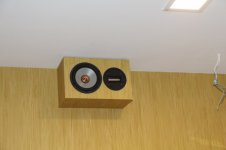
This was my front system in 2012. Every component in that system has since changed (TV, AVR, Front channel amplifier, etc...).
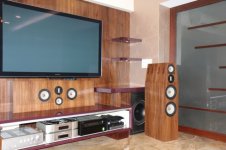
This was my front system in 2012. Every component in that system has since changed (TV, AVR, Front channel amplifier, etc...).
View attachment 1097115
Changed due to the corrosion issue?
Have you checked KLANG+TON 4/2020?Perhaps its time to order the W19NX001 and take some measurements for the benefit of the DIY community- has anyone seen independent measurements?
1. The HDMI chip in the AVR failedChanged due to the corrosion issue?
2. The CD player drive died due to age
3. No one uses a Blu Ray Player anymore, so that was removed too
.....
hello everyone. my first post here.
i want to build a high-end ultra-compact point-source near-field monitor. prefer a closed-enclosure design which will be paired with a closed-enclosure subwoofer. all drivers (H + M + L) will be individually actively amped and fed from an 8-channel mini-dsp.
is the Seas Excel 5" Graphene Cone Coax C16NX001/F (E0080-04/06) a good fit to consider for this design objective? read somewhere that this is more suited to ported enclosures that the previous Magnesium cone version (which is available for half the cost now!).
https://www.madisoundspeakerstore.c...-5-graphene-cone-coax-c16nx001/f-e0080-04/06/
i want to build a high-end ultra-compact point-source near-field monitor. prefer a closed-enclosure design which will be paired with a closed-enclosure subwoofer. all drivers (H + M + L) will be individually actively amped and fed from an 8-channel mini-dsp.
is the Seas Excel 5" Graphene Cone Coax C16NX001/F (E0080-04/06) a good fit to consider for this design objective? read somewhere that this is more suited to ported enclosures that the previous Magnesium cone version (which is available for half the cost now!).
https://www.madisoundspeakerstore.c...-5-graphene-cone-coax-c16nx001/f-e0080-04/06/
That Seas driver seems to be the best "all in one" coaxial driver it has to offer, not something in a multi-way high-end systems. I think for high-end application the MF coaxials are much better(MR18, C18).
You can see all these 16cm coaxial drivers are used in similar applications: tiny cube sized satellites.
Big motor, heavy cone, big surround.. it IS designed for a tiny box with some bass output. Ported or sealed.
http://www.seas.no/images/stories/SoundSolution/PDF_Sound_solution/AV-16_datasheet.pdf
https://exmachinasound.com/titan/
You can see all these 16cm coaxial drivers are used in similar applications: tiny cube sized satellites.
Big motor, heavy cone, big surround.. it IS designed for a tiny box with some bass output. Ported or sealed.
http://www.seas.no/images/stories/SoundSolution/PDF_Sound_solution/AV-16_datasheet.pdf
https://exmachinasound.com/titan/
- Home
- Loudspeakers
- Multi-Way
- Seas Excel Graphene?
